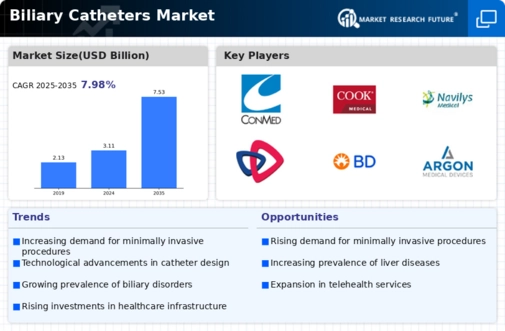Market Share
Biliary Catheters Market Share Analysis
The Biliary Catheters Market is a specialized segment within the medical devices industry, focusing on devices designed for the management of biliary tract disorders. Successfully positioning in this market requires a combination of product innovation, strategic partnerships, regulatory compliance, and a patient-centric approach. Common tactic such as trying to distinguish oneself by developing diverse portfolio of biliary catheters is by the companies. These include catheters used in different procedures including drainage, stenting and dilation addressing the requirements of healthcare personnel and patients with different biliary tract conditions. The most important aspect from the standpoint of market positioning is innovation in catheter design and materials. The companies invest in producing catheters that have state-of-the-art abilities, for instance, better flexibility, better visualization, and capability of working with many imaging modalities. Innovative materials also benefit performance and patient comfort. Spotting strategic partnerships with medical institutions and doctors. These alliances offer an understanding of clinical needs, access to product testing and ultimately improve market reputation. The collaborations also further the incorporation of biliary catheters in the mainstream. Medical devices industry is under strict regulatory standards and adherence to such regulation is a cornerstone. Companies emphasize compliance with regulations since such compliance makes its biliary catheters safe and effective. The strictest of quality assurance measures establish pair with healthcare providers and play a role in market access. In order to grow market share, a business looks out for opportunities to expand to the global sphere. This process is well known as getting government approvals in various parts of the world, localizing products to have a conformity with international standards and putting in place distribution networks. A global footprint permits companies to respond to a wide range of patient need and healthcare practices. Companies, therefore, train and educate the biliary catheter station. It is, workshops, seminars and online resources provide awareness regarding emerging advancements in the field of biliary catheter market which in turn make healthcare professionals to remain updated on the latest techniques and technologies thereby promoting efficiency and expertise in implementing various biliary catheter products. The patient must be enlightened on biliary tract disorders, the functions of catheters, and their use in treatment. patient education programs designed to make patients aware of available treatment options possible benefits and what patients should expect in terms of catheter procedures before, during, and after catheter procedures). Informed patients will also have a higher likelihood of treatment engagement. Biliary catheters market is driven by technological advancements. These technologies that are provided in the catheters are the ones that improve the performance of the catheter; some of the technologies that companies invest in include real-time imaging after the catheter is inserted into the body, navigation capabilities, and inclusion of robotics. Different integration-based technologies take part in procedural efficacy and beneficial patient results. These companies mainly focus on the post-market surveillance process, to ensure the performance and safety of their biliary catheters. Augustine forward. A commitment to improvement is a sign that a company is constantly improving its products which may lead to the production of top medical devices. Recognizing the ongoing nature of biliary tract disorders, companies extend their support beyond the procedural stage. Post-procedure follow-up and support services, including monitoring and addressing patient concerns, contribute to overall patient satisfaction and loyalty.











Leave a Comment